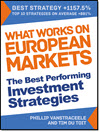The Acquirer’s Multiple is a simple way to beat the market without spending hours on research. This back test shows you the results if you bought the 40 cheapest, Acquirer’s Multiple companies in the USA from 2000 to 2022. You will see the exact rules researchers used, how they kept it honest, and how you can apply it in under 30 minutes a quarter. No forecasts. No guessing. Just a proven system you can use today to build long-term wealth, even if you invest part-time.
Estimated Reading Time: 6 minutes
Can Buying the Cheapest Companies Still Beat the Market? What the Data Says About the Acquirer’s Multiple
Have you ever felt frustrated by complex investment advice? If you want something that works, without needing to watch markets all day or read stacks of financial reports then The Acquirer’s Multiple®, developed by Tobias Carlisle and explained in his great book The Acquirer's Multiple: How the Billionaire Contrarians of Deep Value Beat the Market Acquirer’s Multiple is a strategy built just for that.
It is direct. It is data-driven. And it is easy enough for you to use in under 30 minutes every quarter.
The idea?
Find companies that generate solid profits but are trading at dirt-cheap prices. Then buy the 40 cheapest and let time do the work for you.
Backtesting the Acquirer’s Multiple – 2000 to 2022
A major 2024 research paper Formula Investing by Marcel Schwartz and Matthias X. Hanauer both from the Technical University of Munich put this strategy to the test using 23 years of U.S. market data.
In this post, you will see exactly how the Acquirer’s Multiple was tested, how well it performed, and how you can use it in your own portfolio, even if you only invest a few times a year.
What Was Tested?
Researchers wanted to know: Does the Acquirer’s Multiple strategy still work. To answer that, they tested it on thousands of U.S. stocks from January 2000 to December 2022. That is 23 years, covering bull markets, bear markets, crashes and bubbles.
Here is what they did:
-
Ranked all U.S. stocks using the Acquirer’s Multiple (more on that below).
-
Excluded the smallest and hardest-to-trade stocks.
-
Built portfolios of the 40 cheapest stocks each quarter.
-
Held each group of stocks for 3 months.
-
Repeated the process, again and again, without ever making a prediction.
No cherry-picking. No skipping bad years. Just one clear question: if you followed this strategy blindly, would you beat the market?
What Was Included and What Was Left Out?
To make the results real and usable, the study set firm rules:
Included:
-
All common stocks traded on the NYSE, NASDAQ, and AMEX.
-
Stocks large and liquid enough to be practical for individual investors.
Excluded:
-
Microcap stocks (smaller than the 20th percentile of NYSE-listed companies). These can be illiquid and risky.
-
Financial companies, like banks and insurers, because their financial statements work differently and do not fit the formula.
That means the strategy is designed for stocks you can buy and sell, even with a modest-sized portfolio. It is not about hunting obscure companies; it is about finding value in plain sight.
How the Research Stayed Honest
To get honest results, the researchers followed a strict and transparent process:
-
They used data from CRSP and Compustat, two of the most trusted databases in financial research.
-
They applied a 6-month delay to all financial data. That means if a company filed a report in December, its numbers were not used until June—just like in real life.
-
Portfolios were rebalanced quarterly, using only the data that would have been available at that time.
They also used capped value-weighting, so one or two mega-cap stocks could not dominate a portfolio. These rules made the test fair and kept it aligned with how you would invest your money.
How the Acquirer’s Multiple Strategy Works
Here is how to follow the Acquirer’s Multiple in 4 simple steps:
Step 1: Calculate the Acquirer’s Multiple
This is the heart of the strategy.
Formula: Enterprise Value (EV) ÷ Operating Earnings
-
EV = Market Cap + Debt + Preferred Stock + Minority Interest – Cash
-
Operating Earnings = EBITDA – Capital Expenditures
Think of this as the price tag to buy the whole business (EV), divided by what the business earns. The lower the result, the cheaper the stock.
Step 2: Rank All Stocks
Once every company’s Acquirer’s Multiple is calculated:
-
Rank them from lowest to highest.
-
The lowest 40 are the most undervalued.
Step 3: Build the Portfolio
-
Remove financial stocks and microcaps.
-
Select the 40 cheapest, most investable companies.
-
These are your buys for the quarter.
Step 4: Rebalance Every 3 Months
-
Update the rankings.
-
Sell stocks that fall out of the top 40.
-
Buy any new top-ranked companies.
That is all. No predictions. No second-guessing. Just a formula you can run consistently.
Click here to start using Acquirers Multiple in your portfolio NOW!
Why Quarterly Rebalancing Matters
By updating every 3 months, the strategy:
-
Keeps your portfolio current with new earnings data and stocks that still fits the strategy.
-
Avoids overtrading, which would drive up costs and complexity.
-
Gives stocks time to perform without micromanaging them.
For you, that means just four check-ins per year. It is enough to stay active, without it becoming your second job.
How the Acquirer’s Multiple Performed
The performance of this strategy was strong—and consistent. From 2000 to 2022, the Acquirer’s Multiple delivered:
Annualised Returns, Sharpe Ratios, and Drawdowns
Sharpe Ratio measures risk-adjusted returns (higher is better).
Max Drawdown shows the worst peak-to-trough decline.
CAPM Alpha measures how much a strategy outperforms (or underperforms) the market after adjusting for risk. It tells you whether an investing strategy provides returns that cannot be explained by general market movements.
Source: Formula Investing
-
14.2% annual return, compared to just 7.2% for the market
-
A Sharpe ratio of 0.57, meaning the returns came with manageable risk but drawdown were high so think carefully if you can manage that emotionally!
-
A CAPM Alpha of 6.0%, showing real outperformance even after adjusting for market exposure
That is nearly double the market’s return from one simple, repeatable rule.
Yearly Returns from 2000 to 2022
The following table shows long only annual returns of the 40 top-ranked Acquirer’s Multiple stocks. The portfolios were rebalanced quarterly with value-weighted position sizing capped at the 80th percentile of the NYSE stocks market value.
Market returns are the value-weighted returns of all stocks in the final stock universe. The back test period is 23 years from January 2000 to December 2022.
Source: Formula Investing
Note: I retyped the table and did not get the same values in the research paper. This may because of rounding errors.
When the Strategy Worked Best—and When It Struggled
The Acquirer’s Multiple outperformed the most in:
-
Early 2000s, during the tech bubble bust
-
Post-2008 recovery, when value came back strong
-
2022, as growth cooled off
It struggled during:
-
2018 to 2020, when high-priced growth companies dominated and value was out of favour
But even in those tough years, the long-term results stayed strong. If you had the discipline to stick with it, you came out well ahead.
Click here to start using Acquirers Multiple in your portfolio NOW!
Why The Acquirer’s Multiple Strategy Works
It works because it targets companies that are:
-
Undervalued based on what they earn
-
Overlooked by most investors who chase headlines and hype
-
Often poised for a rebound, a buyout, or a return to normal earnings
The Acquirer’s Multiple removes emotion from investing. It helps you buy what is cheap and profitable, not what is exciting or trendy.
Is This the Right Strategy for You?
You might love this strategy if:
-
You are a long-term investor who values simplicity
-
You have a contrarian nature
-
You believe price matters
-
You prefer to invest based on facts and financials, not forecasts
-
You want a strategy that is easy to run and proven to work
-
You can manage the drawdowns of around 53%
You do not need to be a financial analyst. You just need the right tools and the willingness to follow the system.
Final Thoughts: A Simple Way to Buy Great Businesses Cheap
The Acquirer’s Multiple is not about finding the next big thing. It is about buying real businesses at great prices, quarter after quarter. That is how compounding works in your favour.
It is not always flashy. It does not always win in the short term. But over time, it gives you the edge that most investors only dream of.
👉 Want to try this yourself?
The Quant Investing screener ranks thousands of global stocks by the Acquirer’s Multiple every day. You can build your portfolio in minutes, with the same system used in this study. Simply use the ratio EV to EBITDA or if you prefer percentage values EBITDA Yield or EBITDA to EV.
Start your 30-day free trial today and make value investing simple again.
Click here to start using Acquirers Multiple in your portfolio NOW!
FREQUENTLY ASKED QUESTIONS
1. How do I know if a stock is “cheap” using the Acquirer’s Multiple?
You use a simple formula: Enterprise Value ÷ Operating Earnings.
This tells you how much you are paying for what a company earns. The lower the number, the cheaper the stock.
You do not need to guess what the company is worth—the formula does the hard work.
2. Do I need to check the stock market every day to follow this strategy?
Not at all. You only need to update your portfolio once every 3 months. That means just 4 times a year. You can do it all in under 30 minutes using a stock screener that ranks companies for you.
3. What if a stock I bought falls in price after I buy it?
That happens sometimes. This strategy is not about winning every trade. It is about holding 40 of the cheapest profitable companies and letting time do the work. The backtest shows that even with ups and downs, the strategy doubled the market over 23 years.
4. Can I use this strategy with a small portfolio, like under $100,000?
Yes. The strategy excludes microcap and illiquid stocks. That means every stock it recommends is easy to buy and sell, even with a modest portfolio. You are not buying obscure or risky companies. You are buying undervalued businesses hiding in plain sight.
5. Do I need to understand financial statements to use this strategy?
No. You only need to follow the formula and use a stock screener that does the calculations for you. You do not need to read annual reports or guess what will happen next. This is for long-term investors who want results without spending hours researching.
6. What if I miss a quarterly rebalance—can I still succeed?
Yes. Rebalancing quarterly was done in the back test above, but if you rebalance every 6 months, or even yearly, the strategy can still work well. Just be consistent.
7. Why does this strategy work when others fail?
Because it is fact-based, not forecast-based. It picks companies that are profitable, ignored, and cheap—and gives them time to rebound. While most investors chase trends, you focus on buying real value and letting compounding do the rest.
Click here to start using Acquirers Multiple in your portfolio NOW!
Please note: This website is not associated with Tobias Carlisle, The Acquirer’s Multiple® and acquirersmultiple.com in any way. Neither Mr Carlisle nor acquirersmultiple.com has endorsed this website's investment advice, strategy, or products. Investments recommendations on this website are not chosen by Mr. Carlisle, nor are they based on Mr Carlisle proprietary investment model, and are not chosen by acquirersmultiple.com. The Acquirer’s Multiple® is a registered trademark, which has no connection to this website.


